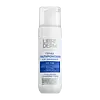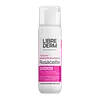What's inside
What's inside
 Key Ingredients
Key Ingredients

 Benefits
Benefits

 Concerns
Concerns

 Ingredients Side-by-side
Ingredients Side-by-side

Water
Skin ConditioningCocamidopropyl Betaine
CleansingHydroxyethyl Urea
HumectantGuar Hydroxypropyltrimonium Chloride
Skin ConditioningSodium Lauroyl Sarcosinate
CleansingDecyl Glucoside
CleansingLauryl Glucoside
CleansingPEG-40 Hydrogenated Castor Oil
EmulsifyingSodium PCA
HumectantSodium Cocoyl Glutamate
CleansingMaltooligosyl Glucoside
Skin ConditioningHydrogenated Starch Hydrolysate
HumectantSodium Hyaluronate
HumectantParfum
MaskingBenzyl Salicylate
PerfumingDisodium EDTA
Citric Acid
BufferingMethylchloroisothiazolinone
PreservativeMethylisothiazolinone
PreservativeMagnesium Nitrate
Magnesium Chloride
Sodium Chloride
MaskingWater, Cocamidopropyl Betaine, Hydroxyethyl Urea, Guar Hydroxypropyltrimonium Chloride, Sodium Lauroyl Sarcosinate, Decyl Glucoside, Lauryl Glucoside, PEG-40 Hydrogenated Castor Oil, Sodium PCA, Sodium Cocoyl Glutamate, Maltooligosyl Glucoside, Hydrogenated Starch Hydrolysate, Sodium Hyaluronate, Parfum, Benzyl Salicylate, Disodium EDTA, Citric Acid, Methylchloroisothiazolinone, Methylisothiazolinone, Magnesium Nitrate, Magnesium Chloride, Sodium Chloride
Water
Skin ConditioningCocamidopropyl Betaine
CleansingGlycerin
HumectantSodium Cocoamphoacetate
CleansingHydroxyethyl Urea
HumectantSodium Cocoyl Glutamate
CleansingSodium Cocoyl Apple Amino Acids
Skin ConditioningSodium PCA
HumectantPolyglyceryl-6 Caprylate
EmulsifyingPolyglyceryl-3 Cocoate
EmulsifyingAllantoin
Skin ConditioningPolyglyceryl-4 Caprate
EmulsifyingCitric Acid
BufferingPolyglyceryl-6 Ricinoleate
EmulsifyingParfum
MaskingChlorphenesin
AntimicrobialMagnesium Nitrate
Methylchloroisothiazolinone
PreservativeMagnesium Chloride
Methylisothiazolinone
PreservativeButylene Glycol
HumectantVincetoxicum Atratum Root Extract
EmollientCornus Officinalis Fruit Extract
Skin ConditioningDimethyl Sulfone
SolventDipotassium Glycyrrhizate
HumectantTetrasodium EDTA
Water, Cocamidopropyl Betaine, Glycerin, Sodium Cocoamphoacetate, Hydroxyethyl Urea, Sodium Cocoyl Glutamate, Sodium Cocoyl Apple Amino Acids, Sodium PCA, Polyglyceryl-6 Caprylate, Polyglyceryl-3 Cocoate, Allantoin, Polyglyceryl-4 Caprate, Citric Acid, Polyglyceryl-6 Ricinoleate, Parfum, Chlorphenesin, Magnesium Nitrate, Methylchloroisothiazolinone, Magnesium Chloride, Methylisothiazolinone, Butylene Glycol, Vincetoxicum Atratum Root Extract, Cornus Officinalis Fruit Extract, Dimethyl Sulfone, Dipotassium Glycyrrhizate, Tetrasodium EDTA
Ingredients Explained
These ingredients are found in both products.
Ingredients higher up in an ingredient list are typically present in a larger amount.
Citric Acid is an alpha hydroxy acid (AHA) naturally found in citrus fruits like oranges, lemons, and limes.
Like other AHAs, citric acid can exfoliate skin by breaking down the bonds that hold dead skin cells together. This helps reveal smoother and brighter skin underneath.
However, this exfoliating effect only happens at high concentrations (20%) which can be hard to find in cosmetic products.
Due to this, citric acid is usually included in small amounts as a pH adjuster. This helps keep products slightly more acidic and compatible with skin's natural pH.
In skincare formulas, citric acid can:
While it can provide some skin benefits, research shows lactic acid and glycolic acid are generally more effective and less irritating exfoliants.
Most citric acid used in skincare today is made by fermenting sugars (usually from molasses). This synthetic version is identical to the natural citrus form but easier to stabilize and use in formulations.
Read more about some other popular AHA's here:
Learn more about Citric AcidCocamidopropyl Betaine is a fatty acid created by mixing similar compounds in coconut oil and dimethylaminopropylamine, a compound with two amino groups.
This ingredient is a surfactant and cleanser. It helps gather the dirt, pollutants, and other impurities in your skin to be washed away. It also helps thicken a product and make the texture more creamy.
Being created from coconut oil means Cocamidopropyl Betaine is hydrating for the skin.
While Cocamidopropyl Betaine was believed to be an allergen, a study from 2012 disproved this. It found two compounds in unpure Cocamidopropyl Betaine to be the irritants: aminoamide and 3-dimethylaminopropylamine. High-grade and pure Cocamidopropyl Betaine did not induce allergic reactions during this study.
Learn more about Cocamidopropyl BetaineWe don't have a description for Magnesium Chloride yet.
We don't have a description for Magnesium Nitrate yet.
MCI is a preservative and known skin-irritant. It has anti-bacteria anti-fungal properties.
Studies spanning several decades have shown this ingredient to cause skin irritation and allergies.
MCI is commonly combined with methylisothiazolinone (MI). Other names for this mixture include Kathon CG and Euxyl K 100.
The use of this ingredient varies around the world:
Learn more about MethylchloroisothiazolinoneMI is a preservative and known skin irritant. In the past, MI was used for its ability to prevent bacteria, yeast, and fungi growth in low doses.
Nowadays, you'll most likely see MI combined with Methylchloroisothiazolinone (MCI). Trade names for this combination include Kathon CG or Euxyl K 100.
Since then, numerous studies have shown this ingredient to cause contact dermatitis, or skin irritation.
The use of this ingredient varies around the world:
Learn more about MethylisothiazolinoneParfum is a catch-all term for an ingredient or more that is used to give a scent to products.
Also called "fragrance", this ingredient can be a blend of hundreds of chemicals or plant oils. This means every product with "fragrance" or "parfum" in the ingredients list is a different mixture.
For instance, Habanolide is a proprietary trade name for a specific aroma chemical. When used as a fragrance ingredient in cosmetics, most aroma chemicals fall under the broad labeling category of “FRAGRANCE” or “PARFUM” according to EU and US regulations.
The term 'parfum' or 'fragrance' is not regulated in many countries. In many cases, it is up to the brand to define this term.
For instance, many brands choose to label themselves as "fragrance-free" because they are not using synthetic fragrances. However, their products may still contain ingredients such as essential oils that are considered a fragrance by INCI standards.
One example is Calendula flower extract. Calendula is an essential oil that still imparts a scent or 'fragrance'.
Depending on the blend, the ingredients in the mixture can cause allergies and sensitivities on the skin. Some ingredients that are known EU allergens include linalool and citronellol.
Parfum can also be used to mask or cover an unpleasant scent.
The bottom line is: not all fragrances/parfum/ingredients are created equally. If you are worried about fragrances, we recommend taking a closer look at an ingredient. And of course, we always recommend speaking with a professional.
Learn more about ParfumSodium Cocoyl Glutamate is a gentle cleanser and surfactant. It is the sodium salt of the Cocoyl Glutamic Acid and comes from coconut oil. As a surfactant, it helps lift dirt and oil to be washed away.
Sodium Cocoyl Glutamate also has an emolliating effect and can help leave the skin feeling soft.
Sodium PCA is the sodium salt of pyroglutamic acid. It is naturally occurring in our skin's natural moisturizing factors where it works to maintain hydration.
The PCA stands for pyrrolidone carboxylic acid, a natural amino acid derivative.
This ingredient has skin conditioning, anti-inflammatory, and humectant properties. Humectants help hydrate your skin by drawing moisture from the air. This helps keep your skin moisturized.
Learn more about Sodium PCAWater. It's the most common cosmetic ingredient of all. You'll usually see it at the top of ingredient lists, meaning that it makes up the largest part of the product.
So why is it so popular? Water most often acts as a solvent - this means that it helps dissolve other ingredients into the formulation.
You'll also recognize water as that liquid we all need to stay alive. If you see this, drink a glass of water. Stay hydrated!
Learn more about Water